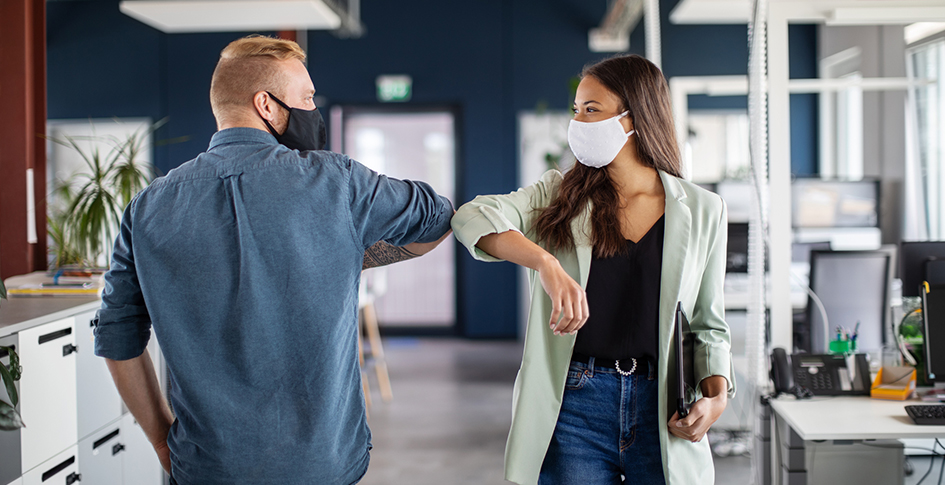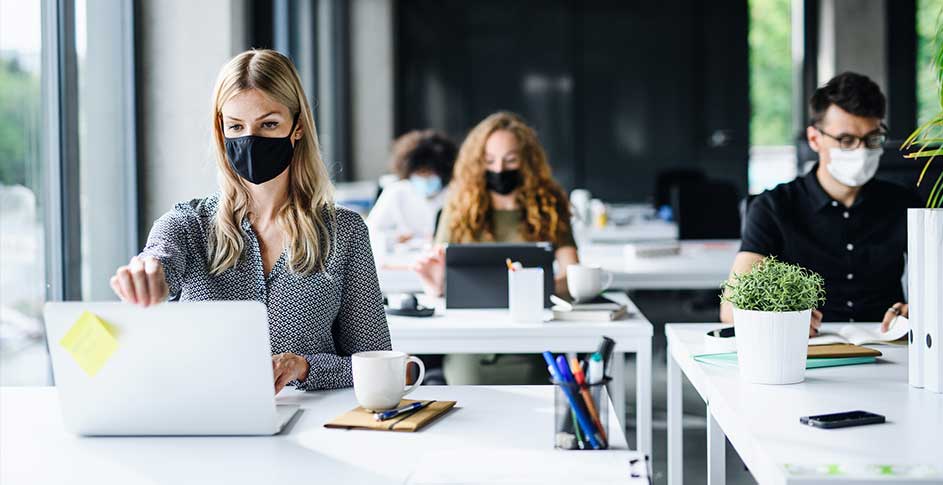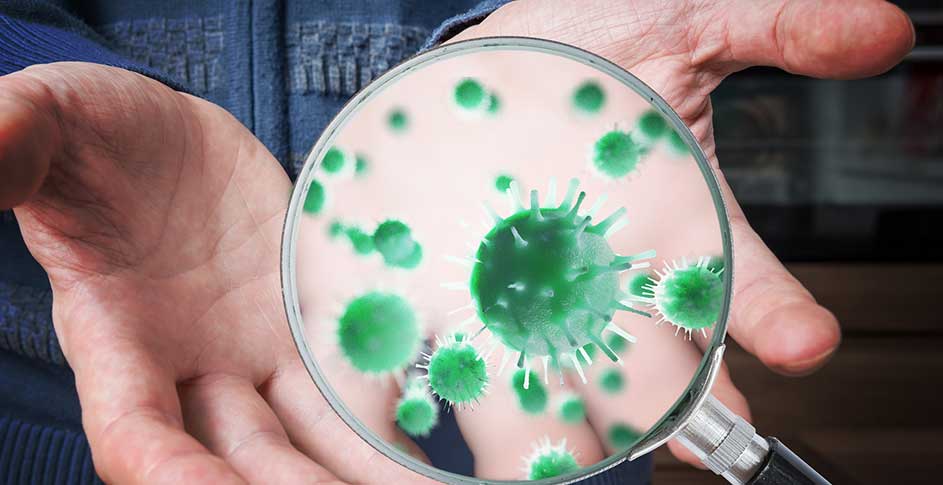Ah, the corporate office building! Alas, many of your employees haven’t basked in its fluorescent glory for nearly two years. Soon, however, everyone will happily huddle once more in that near-windowless, monochromatic hive. After all, the air conditioning needs to blow the stagnant, freezing air of a thousand recycled sneezes down the back of somebody’s neck, or what’s an office for?
Perhaps employees would be eager to return sooner if the office was a place worth returning to. And no, changing the blue-gray chairs to red beanbags isn’t going to do it. You need to improve office health—physically, mentally, aesthetically, and emotionally. Being an air purification company, we can’t help you with interior design or corporate culture (at least not directly); but we can help with the peace of mind that comes from improved air quality.
In our last article, we discussed the reduction of VOCs, with a focus on the industrial workplace. In this article, we will discuss another workforce air pollutant—particulate matter—with a focus on the conventional office. We will define particulate matter, explore where it comes from, and explain how to reduce particulates in the office.
What is particulate matter?
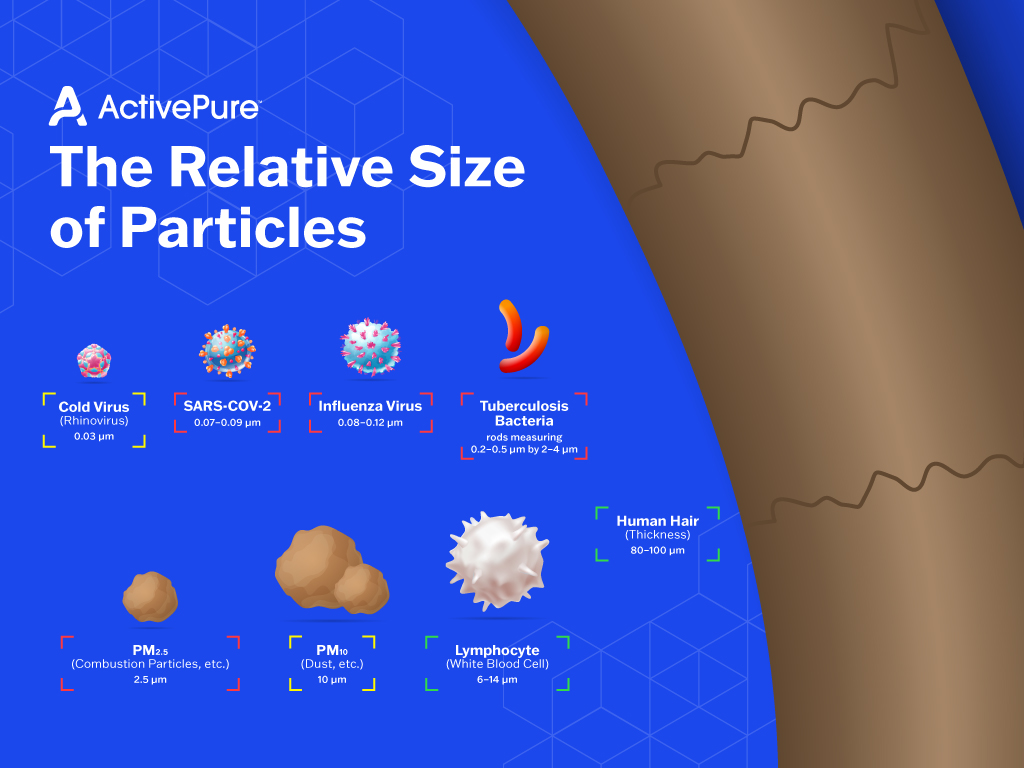
Particulate matter is a mix of liquid and solid particles which are small enough to remain suspended in the air. They come in a variety of sizes. In general, the smaller the particle, the more danger it poses to human health.
Though particulate matter can vary widely in size, regulators and researchers tend to split them into three categories abbreviated as PM10, PM2.5, and PM0.1:
- What does PM10 mean? PM10 refers to particulate matter around 10 microns (one millionth of a meter) or smaller.
- What does PM2.5 mean? PM2.5 refers to particulate matter around 2.5 microns or smaller.
- What does PM0.1 mean? PM0.1 refers to particulate matter 0.1 microns or smaller (also sometimes known as “ultrafine particles”). To put that in perspective of scale, if PM2.5 was a football field, PM0.1 wouldn’t even be a first down.
Please note the “or smaller” in the definitions above. Think of PM as a diagram with three circles inside of each other. For instance, PM10 includes PM2.5 and PM0.1, but PM0.1 does not include PM10 and PM2.5. Make sense? (Admittedly, popular usage of PM10 refers to larger particles only, while PM2.5 is used to refer to medium particles only. But scientifically speaking, the three categories nest inside each other like Russian dolls.)
What causes PM pollution?
Most large particulate matter comes from natural sources such as dust, pollen, or mold. However, construction, landfills, and agriculture may also contribute.
By contrast, most (but not all) smaller particulate matter tends to come from human activities. PM2.5 (and by extension PM0.1) is created by cars, factories, power plants, road construction, cigarette smoke, trash burning, and many other industrial activities. However, forest fires and sea spray also create smaller PM2.5.
Also note that particulate matter can be primary or secondary. Primary particulate matter enters the atmosphere directly from its source—for instance, a fire sending off soot. Secondary particulate matter, by contrast, forms in the air from a series of complex chemical reactions. Combustion gasses, certain VOCs, sunlight, and water all may interact to form secondary particulate matter; secondary particulate matter is usually smaller, and therefore more dangerous.
 Office air quality arguments can get heated. Keep it cool with ActivePure. Image credit: Aja Koska / Getty
Office air quality arguments can get heated. Keep it cool with ActivePure. Image credit: Aja Koska / Getty
What are the health effects of particulate matter?
PM exposure, both short-term and long-term, can cause a whole range of health problems. Short-term exposure to PM10 is associated with the worsening of existing respiratory symptoms, while short-term exposure to PM2.5 is “associated with premature mortality, increased hospital admissions for heart or lung causes, acute and chronic bronchitis, asthma attacks, emergency room visits, respiratory symptoms, and restricted activity days[...]Long-term (months to years) exposure to PM2.5 has been linked to premature death, particularly in people who have chronic heart or lung diseases[...]” (California Air Resources Board).
Oof, that’s a lot of respiratory and cardiovascular problems! However, exposure to fine particles doesn’t just make your workers sicker; it also makes them dumber. Really!
A study by the Harvard T.H. Chan School of Public Health tested people’s performance on cognitive tests under elevated levels of PM2.5 and carbon dioxide. According to the school’s website, “The study found that response times on the color-based test were slower as PM2.5 and CO2 levels increased. They also found that accuracy on the color-based test was affected by PM2.5 and CO2 levels.” The study did not find the PM2.5 impaired cognition on math-based activities, however “[as] concentrations of both pollutants increased[...]participants completed fewer questions correctly in the allotted test time.”
In other words, if your office has high levels of PM2.5, your workers will not be working as quickly or as accurately as they would in cleaner air.
What does particulate matter cost employers?
Particulate matter isn't limited to negative physical and mental effects. Elevated particulate matter also has a negative economic impact.
PM2.5 health effects result in increased sick time. For instance, in the United Kingdom, the Clean Air Fund estimates that employees took three million sick days per year due to air pollution; (and the UK has fairly clean air compared to some countries). Meanwhile, India—with the fifth-worst air quality on Earth and a much larger population—lost 1.3 billion working days due to air pollution. On top of this, employees without paid sick days miss wages due to air pollution; this costs the consumer economy as a whole.
The United States is not exempt from these effects. A Massachusetts study calculated the cost of sick leave due to poor building ventilation and indoor environmental quality; they found that neglect in these areas cost employers $840 dollars per employee per year or $40 billion on a national scale (adjusted for inflation).
This sick time (plus the aforementioned impairments to cognitive function) results in lower productivity. A study of California pear packers found that an “increase in PM2.5 pollution of 10 micrograms per cubic meter (µg/m3) reduces the productivity of workers by $0.41 per hour, approximately 6 percent of average hourly earnings.”
Well, it’s certainly clear that particulate matter is something you want your employees to breathe in as little as possible. Unfortunately, they’re breathing it in anyway.
 Ah, “fresh” air. Image Credit: Robert Daly / Getty
Ah, “fresh” air. Image Credit: Robert Daly / Getty
Where does office PM come from?
Particulate matter, as discussed above, can come from many sources. Below are some additional sources of ‘particular’ (pun intended) concern for offices.
1. Meal prep
Home cooking can release particulate matter indoors, especially frying or sauteing. However, we assume that most employees aren’t cooking a 10-course teppanyaki meal during their lunch. Even typical office foods, though, may release fine particulate matter. For instance, a 2013 study found that microwaved popcorn produced 300-800 times the PM2.5 emissions of microwaved water. This doesn’t mean you should ban popcorn in the office; (we wouldn’t want you to have a revolt on your hands). It’s just a reminder that PM2.5 is going to be generated by normal office activities, so it’s good to have a plan to deal with it. Speaking of normal office activities…
2. Laser printers
A study of office particulate matter made headlines in 2007 when it discovered that office laser printers were spiking particle concentration five times higher than after-hours levels. While this study admitted that only 40% of printer types were to blame, these 40% were responsible for quite a bit.
Of course, a 15-year old study is no reason to change your office technology. A revisit of printer pollution in 2020 found that “The health risk from exposure to [printer] particles is small compared with the health risk from exposure to ambient particles.” Most of the particles emitted by printers are semi-volatile organic compounds (SVOCs). SVOCs have a higher boiling point than VOCs, so they tend to quickly solidify—falling out of the air and onto surfaces. This means printer emissions—while not necessarily safe—are of less concern than particles which come from other sources. Speaking of other sources…
3. Vacuuming
Janitorial services may increase particulate matter in the office as well. Particulate matter is exuded during vacuuming because contaminants are stirred up in the process of trying to get rid of them. Particulates may also be shed by the vacuum motor itself. However, according to a 2020 study, “HEPA filters can significantly reduce the PM emitted by the vacuum cleaner motor.” If only there was a company with a century-longlegacy of making quality vacuum cleaners and an extensive line of both home and commercial HEPA models. (*Coughs pointedly*.) Speaking of product lines…
4. Perfumes, new furniture, and cleaning products
As we discussed above, certain VOCs can mix with combustion gasses and sunlight to form secondary particulate matter. Is it therefore possible that the sources of VOC in the office (off-gassing from carpets and furniture, cleaning supplies, perfume, cologne, etc.) could be creating even more particulate matter indoors?
Perhaps, and perhaps not. However, a recent study of VOC concentration in Los Angeles county found that HALF (half? All caps are good tho, for emphasis) of all VOCs in the air were not from infamous polluters like factories and automobiles, but from personal sources like cleaning products, wall paint, and perfume. Since VOCs interact outdoors to form new particulate matter, your work VOCs may be indirectly contributing outdoor particulate matter. Speaking of the outdoors…
5. Outdoor infiltration
One of the biggest considerations of indoor air quality is outdoor air quality. For instance, a 2017 study of Daqing, China found that 70% of indoor particulate matter came from outdoor sources (albeit this is an average which includes both office buildings and homes). Similarly, a 2004 study of buildings in Erfurt, Germany found a strong correlation between outdoor and indoor air quality.
However, a 2015 Swiss study of homes found that the correlation between indoor and outdoor air quality was low. According to that study, “Our results show that a careful evaluation of home characteristics is needed when estimating indoor exposure to pollutants with outdoor origin.” In other words, the buildings themselves matter a lot. That brings us to our next point.
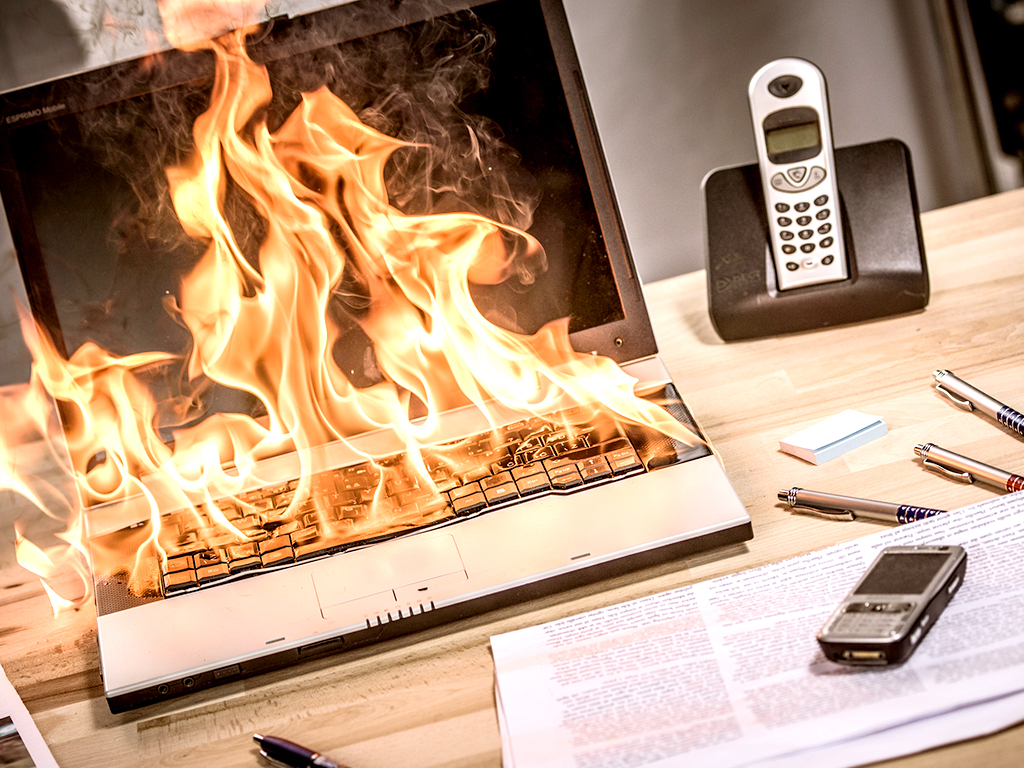 There might be other sources we missed. We don’t know what Tuesdays are like at your office. Image Credit: simonkr / Getty
There might be other sources we missed. We don’t know what Tuesdays are like at your office. Image Credit: simonkr / Getty
How can I reduce particulate matter in office air?
You can and should seek to improve the air quality in your office environment. The EPA highlights three methods: source control, improved ventilation, and air cleaners.
1. Source control
Once again, we’re not suggesting you eliminate popcorn, perfume, and printers. However, you can make sure your office is nonsmoking; (that’s a big one). In addition, invest in vacuums containing HEPA filters for your environmental staff.
2. Improve ventilation
Believe it or not, this doesn’t mean opening the windows. (Likely, your office windows don’t open anyway.) What it does mean is using a ventilation system that brings in a healthy supply of outdoor air. ASHRAE (American Society of Heating, Refrigerating and Air-Conditioning Engineers) recommends that for every person in the office, your ventilation system should be capable of moving five cubic feet of air per minute (at least for a standard non-smoking area).
It’s hard to overstate the purpose of a good ventilation system. In a study of 37 urban office spaces across three different countries, the Harvard Healthy Buildings program found that while indoor PM2.5 levels increased during poor air quality days, properly maintained ventilations systems were a very important mitigation. This was evidenced by the fact that building PM2.5 levels were higher at night (when ventilation systems were turned off) rather than during the height of office activity (as might be expected). The study cited MERV 13 filters as particularly effective.
To improve energy efficiency for your ventilation, make sure you install an ERV, HRV, or MHRV. These chambers transfer heat (and sometimes moisture) between ingoing and outgoing airstreams so that the building's HVAC system doesn’t have heat or cool the new air all over again.
3. Invest in air cleaners
If your building is in an area with high particulate matter pollution, outdoor air will need to be filtered before it enters the building. MERV 13 filters are recommended for filtering air that comes into the building from your HVAC system.
However, installing high MERV filters into the existing HVAC system might not be an option for your building. If the pressure drops and energy demands are too much of a strain on the system, you may wish to install a filter with a lower MERV rating in the duct system.
Then, supplement these lower MERV filters with portable air cleaners which can handle the higher MERV of a true HEPA filter. True HEPA filters (MERV 17 or higher) “remove at least 99.97% of dust, pollen, mold, bacteria, and any airborne particles with a size of 0.3 microns,” according to the EPA.
(“Whoa! Where did the PM0.3 come from?” you ask? “I thought we were talking about PM2.5 and PM0.1.” Good question! PM0.3 is used to rate filters, as it is the most difficult size of particle to capture.)
Hint: Many purifiers pair ActivePure Technology with HEPA filters. Thus, they have the bonus of removing particulate matter while also reducing pathogens and VOCs. Pathogen and VOC removal is another good reason to invest in portable purifiers, even if you already have MERV 13 induct filters.
 Pictured: the second easiest way to bring fresh air into the office. The easiest is ActivePure. Image Credit: Thomas Northcut / Getty
Pictured: the second easiest way to bring fresh air into the office. The easiest is ActivePure. Image Credit: Thomas Northcut / Getty
A few, final words
To incentivize employees to return to the office, you need to make the office a place worth returning to. This means more than just free pizza on Fridays and standing desks. It means making the office a place employees can breathe (and think) easily. Source control of particulate matter (including proper vacuuming equipment), improved ventilation, and investment in filtration can go a long way towards making the office a comfortable and clean environment for all.
Want help making it happen? Contact ActivePure today. We’ll connect you with a licensed distributor who can advise on the best air quality improvement plan for your office.
